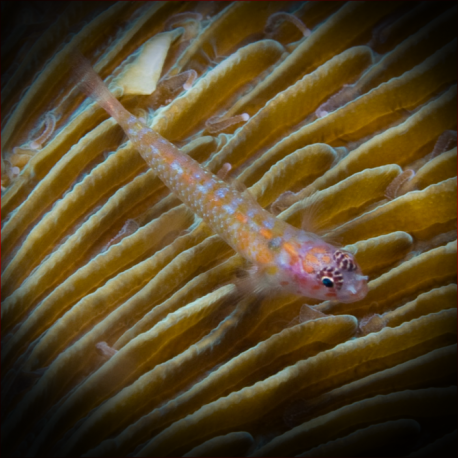More info
Datasheet
| Minimum Tank Size | 50 litres / 13.21 US gallons |
| Maximum Size | 4.0cm / 1.57inches |
| Reef Compatible | Always reef safe |
| Temperament | Docile but might be aggressive towards similar species |
| Temperature | 22.2°C / 71.96°F - 25.6°C / 78.08°F |
| Specific Gravity | 1.020-1.025 |
| Carbonate Hardness | 8-12 |
| pH | 8.1-8.4 |
General Description:The Spotted Fringefin Goby, also known as the Whiteline Pygmy Goby or White-barred Pygmy-goby, is a tiny fish belonging to the Gobiidae family. These fish are small in size, with a maximum length of 4.0cm, and have a short lifespan lasting only a few months.
Aquarium Suitability:Considered suitable for aquariums, the Spotted Fringefin Goby requires specific care due to its small size and shy, docile nature. They are generally hardy, making them a good choice for aquarists willing to provide the necessary conditions.
Demands, Care, and Hardiness:This species thrives in well-established aquariums with ample hiding places, like live rocks, and a significant population of micro life such as copepods and amphipods. They are docile but may show aggression towards similar species, so caution is advised when selecting tankmates.
Reef Suitability:The Spotted Fringefin Goby is considered reef-compatible and is known to be safe for reef setups, adding a small and interesting element to the microenvironment.
Aquarium Setup:For optimal care, provide a tank with a minimum size of 50 liters and maintain water conditions within a temperature range of 22.2-25.6°C, pH of 8.1-8.4, and a specific gravity of 1.020-1.025. Ensure the presence of hiding spots and a well-established pod population for the goby's sustenance.
Behaviour:These gobies are shy by nature and tend to hide among the intricate structures within the aquarium, showing minimal aggression towards tankmates. Observing their behavior can be fascinating due to their small size and unique movements.
Feeding and Diet:The Spotted Fringefin Goby primarily feeds on small crustaceans like krill, mysis, and artemia, as well as zooplankton such as cyclops and pods. Frequent feeding several times a day is recommended, especially upon introduction to a new environment.
Dimorphism:Though there is no specific information available on dimorphism or captive reproduction for this species, it is worth noting that they can be bred in captivity, leading to the potential availability of captive-bred specimens.
Habitat and Distribution:These gobies are native to the Pacific Ocean, specifically found in the Society Islands, Line Islands, and Tuamotu Archipelago. With a distribution limited to certain areas, they prefer specific habitats within these regions for their survival and reproduction.

